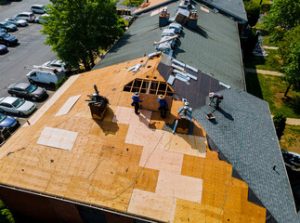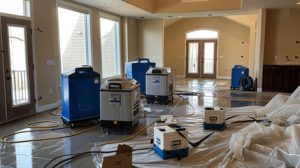Roofing contractors specialize in roof installation, repair and maintenance. They may work independently or as part of a larger company.
Manufacturer certification isn’t a marketing gimmick; it’s a sign of quality. Ask the contractor to provide references and a portfolio of past jobs. Visit https://www.fivestarroofingandcontracting.com/ for more information.

Look for a written estimate that details costs and project timelines. Compare quotes and consider materials, labor, warranties and customer service.
1. Experience
Whether you’re a homeowner in need of roof repair, a building owner looking for a new roof, or an architect drawing plans for new construction, you want to work with a professional roofing contractor. Licensed and certified roofers follow industry standards, ensure safety, and provide quality workmanship. A good roofing contractor will be familiar with the various types of roofing, their installation methods, and weather conditions in your area. They can help you choose the best roofing material for your home and will work well with other contractors, like electricians and plumbers, to make sure all aspects of a project integrate properly.
Roofing contractors should be able to demonstrate their experience with examples of previous jobs they have carried out and have references that they can put you in touch with for genuine feedback. Be wary of any contractor that uses stock photography on their website and does not display their own work.
You should also ask about the contractor’s supervision approach and communication protocols during a job. Reliable roofers can detail how they manage projects with multiple crew members and address common issues, like weather delays (which are prevalent in Chester and Delaware County) or supply chain disruptions. They will also explain how they protect landscaping, siding, and driveways during roofing and cleanup processes and communicate these measures clearly to you.
Whether you’re working with a local roofing contractor or a national one, be aware that prices can fluctuate after severe storms when demand spikes. Regardless of the price, you should always be vigilant about paying attention to the quality of work and materials provided by your roofer. Choosing an inexperienced contractor or one that cuts corners can lead to costly problems down the road.
2. Certification
When it comes to choosing a roofing contractor, the right one can make or break your project experience. Whether you’re looking for roof repair or a total replacement, a quality job will protect not only your home but everything and everyone inside it. Understanding how to vet contractors with smart questions can help you feel confident in your choice and make the best decisions for your property.
The roofing industry is highly specialized and requires professional training to ensure the highest levels of service and quality. Unlike general handymen who may have a wide range of skills, roofing contractors focus solely on their trade and often hold manufacturer certifications like CertainTeed’s SELECT ShingleMaster designation that confirm they follow strict installation guidelines. Choosing a certified contractor is the best way to guarantee a professional outcome on your roofing project.
You should also ask about the licensing requirements for your state or local area. Most states require a roofing license for residential and commercial roofing contractors. The requirements vary by state but typically include: a business entity, proof of financial responsibility, insurance or bonding, and workers’ compensation. Some states also require additional qualifications, such as experience or the completion of an exam.
A trustworthy roofing contractor will be transparent about any additional costs or unforeseen issues that may arise during the project and work with you to find solutions that fit your budget. They will provide a written estimate that clearly details the cost of materials and labor and communicate regularly about the status of your project. This can prevent unexpected expenses, delays and disruptions that might otherwise derail your project. Moreover, you should always request references and read online reviews to gauge a contractor’s reliability and customer satisfaction.
3. Insurance
Insurance is an integral component of any business, and roofing contractors are no exception. Before hiring a contractor, request copies of their liability and workers’ compensation coverage and verify they’re in effect throughout the duration of your project. In addition, the NRCA recommends requesting client references and a list of completed projects to gauge a contractor’s reputation and satisfaction level.
General Liability Insurance is an indispensable tool for roofing contractors, protecting them from third-party bodily injuries and property damage during a roof installation or repair. This type of insurance offers a safety net for accidents that can occur on the job site, such as a client falling off the ladder or an employee breaking a window during hauling materials.
Additionally, a quality roofing contractor should carry Commercial Auto Insurance to protect any vehicles used in the course of business. This includes trucks, vans, and any other vehicles that may be needed to transport equipment to and from job sites. In most states, this is a legal requirement and it also helps to manage costs by ensuring that any accident-related expenses are covered.
Finally, a reputable roofing contractor should have Inland Marine Insurance to protect any tools or equipment that are in transit or stored away from the job site. This coverage protects against theft and vandalism, as well as other potential risks such as fire or flood.
Although a roofing contractor can provide an estimate and inspect the damage, they cannot approve an insurance roof replacement or determine how much an insurance company will pay to cover the repairs. However, a reputable roofing contractor can help navigate the insurance claims process by offering detailed estimates, assisting with inspections, and communicating with insurance adjusters.
4. Warranties
When it comes to roofing, warranties are a great way to ensure that your investment is protected. However, it is important to understand the different types of warranties available and how they work before making a decision. Choosing a contractor with quality materials and a solid track record is one of the best ways to ensure that you are getting a warranty that will provide you with peace of mind for years to come.
Manufacturer warranties and workmanship warranties are two separate types of warranties that offer a range of protections for your roofing project. Manufacturer warranties cover the specific products used to build your roof, including shingles, metal panels, and other materials. These warranties typically guarantee the performance and durability of the materials for a specified period, and they can be transferred to new homeowners when you sell your home.
Workmanship warranties, on the other hand, cover the installation process. While they are less comprehensive than manufacturer warranties, they still protect against damage caused by faulty installation and other errors. Most contractors will offer some form of a workmanship warranty, and if they do not, it is important to find another contractor.
In addition to being aware of the different types of warranties, it is also important to understand the terms and conditions of each. For example, a manufacturer warranty will only be valid if the product is installed according to the guidelines provided by the manufacturer. Deviating from these guidelines can void your warranty, so be sure to read the documentation carefully before starting the project. It is also important to consider the impact that environmental factors can have on your roofing system, as this may affect how quickly your warranty will wear out.
5. Customer Service
If a contractor has strong communication and customer service skills, clients can feel confident they’ll be kept updated throughout the project. They’ll also be transparent about any additional costs that may arise and work with the client to find solutions that fit their budget.
Ask your friends, family and neighbors for recommendations of roofing contractors that have provided them with excellent service. This remains one of the best ways to filter out unreliable options. Contacting your local building department or inspector can also provide insights into the quality of a contractor’s work. If a particular roofer has a habit of failing inspections, that’s an indicator they’re not following industry standards and best practices.
You’ll also want to learn about the project management approach and how weather delays, common in this region, or supply chain issues will be handled. Reliable roofing contractors are realistic about scheduling and communicate proactively about any potential delays so they can minimize inconvenience to their clients.
It’s always best to hire licensed professionals for any home improvement projects. Licensing shows accountability, and liability insurance will protect you if someone falls off your roof or damages your property. All roofing contractors should carry workers’ compensation, general liability and commercial auto insurance. This will cover medical expenses, lost wages and property damage should an employee get injured on the job or if they are hurt while working on your home.
